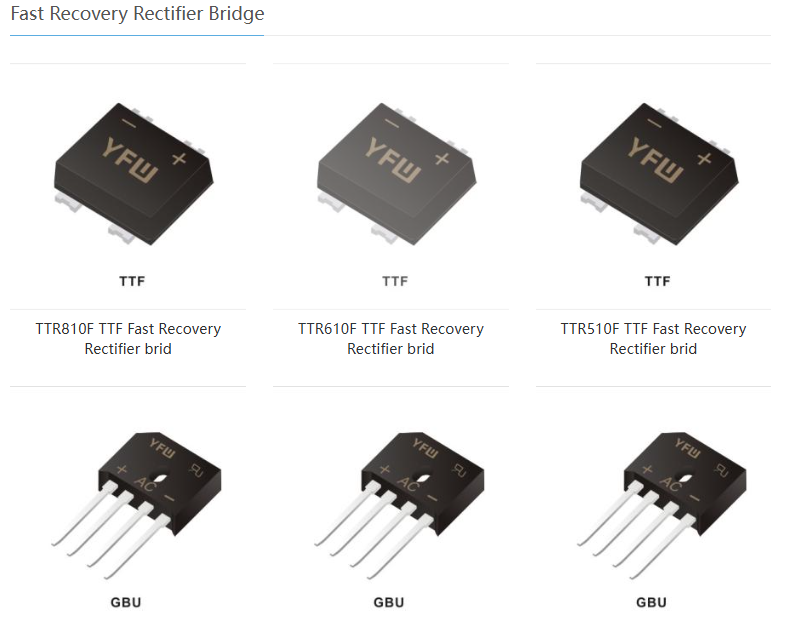A fast recovery bridge is a rectifier device widely used in power electronics, usually in circuits that require high current and fast recovery characteristics. Due to its fast switching characteristics, the fast recovery bridge performs well in high-frequency environments. However, with increasing use or under improper operating conditions, the fast recovery bridge may experience damage or degraded performance.
1. Judged by output voltage test
When damage to a fast recovery bridge is suspected, the most straightforward way to detect it is to measure its output voltage. The main function of the fast recovery bridge is to convert the input alternating current to direct current, if the output voltage is not normal, it is likely that there is a problem with the fast recovery bridge.
Test Steps:
First of all, make sure that the equipment is powered off and perform a physical inspection of the quick recovery bridge to confirm that there is no visible damage to its appearance.
Use a multimeter to measure the input voltage of the fast recovery bridge to ensure that the input voltage is normal.
Next, the output voltage of the fast recovery bridge is measured. Under normal circumstances, the output should provide a stable DC voltage. If the measured output voltage deviates significantly from the expected value, such as too low, too high, or no output, it may mean that the fast recovery bridge is damaged.
2. Judged by diode function test
The fast recovery bridge is composed of multiple fast recovery diodes, and the characteristics of these diodes directly determine the performance of the fast recovery bridge. The diode test function of the multimeter can be used to test the working status of these diodes one by one.
Test Steps:
Adjust the multimeter to diode test mode.
The forward voltage drop for each diode in the fast recovery bridge is tested on a case-by-case basis, which should typically be between 0.2V and 0.8V.
If a diode has a forward voltage drop of 0 or infinity, the diode may be shorted or open, causing the fast recovery bridge to fail.
3. Judged by the switch characteristic test
One of the key features of the fast recovery bridge is its fast recovery feature, which means that the recovery time between switched states is very short. Therefore, it is possible to determine whether the fast recovery bridge is working properly by measuring its switching characteristics.
Test Steps:
Using an oscilloscope or other high-frequency test equipment, measure the waveform characteristics of the fast recovery bridge during the switching process.
Check the recovery time parameter (TRR), generally the recovery time of the fast recovery diode should be between tens of nanoseconds and hundreds of nanoseconds.
If the measured recovery time is significantly longer than typical in the datasheet, or if there is an anomaly in the waveform, such as excessive ringing or noise, it may indicate that the fast recovery bridge is damaged.
4. Judged by temperature monitoring
When the fast recovery bridge works under high-frequency and high-current conditions, it generates a certain amount of heat. If a diode is damaged or degraded, it can lead to a significant increase in heat. Therefore, the temperature anomaly can also be used as an important basis for judging the damage of the fast recovery bridge.
Test Steps:
Let the device run in normal working condition for a period of time, and use an infrared thermometer or thermal imager to measure the temperature distribution of the fast recovery bridge.
Under normal circumstances, the temperature of the fast recovery bridge should be uniform and within a safe range. If the temperature in an area rises abnormally, it may mean that the internal diodes are damaged, resulting in localized overheating.
5. Visually inspect and smell judged
Although damage to a fast-recovery bridge usually does not manifest as a noticeable change in appearance, when severely damaged, it may be burned, cracked, and even accompanied by a pungent odor.
Key points to check:
Check the appearance of the recovery bridge for obvious physical damage, such as scorch marks, packaging cracks, etc.
An olfactory inspection can also provide some clues before an electrical test, especially when equipment fails, and damage to a quick recovery bridge is often accompanied by a noticeable burning odor.
Damage detection of fast recovery bridge requires a combination of test methods, including voltage measurement, diode testing, switching characteristic testing, temperature monitoring, and visual inspection.
Contact: Emma Tan
Phone: +8613650089053
E-mail: emma@yfwdiode.com
Add: No.9 Cuibi street,Nancheng,Zhang mutou town,Dongguan City,Guangdong Province